- Home
- Resources
- Work samples
- Samples
- Radioactivity – ABOVE
Science
Year 9
Above satisfactory
Radioactivity and its application
 1
Annotation 1
1
Annotation 1
Acknowledges that scientific understanding develops over time and results from many individual contributions 2 Annotation 2
Describes and contrasts different historical models of the atom
-
Annotations
-
1
Annotation 1
Acknowledges that scientific understanding develops over time and results from many individual contributions -
2
Annotation 2
Describes and contrasts different historical models of the atom
 1
Annotation 1
1
Annotation 1
Draws diagram of an atom including electron shells 2 Annotation 2
Explains how electrons are organised into shells
-
Annotations
-
1
Annotation 1
Draws diagram of an atom including electron shells -
2
Annotation 2
Explains how electrons are organised into shells
 1
Annotation 1
1
Annotation 1
Explains what isotopes are with references to relative abundances and correct scientific notation
-
Annotations
-
1
Annotation 1
Explains what isotopes are with references to relative abundances and correct scientific notation
 1
Annotation 1
1
Annotation 1
States cause of radioactivity 2 Annotation 2
Uses graph to explain the quantitative nature of radioactive decay including term half-life
-
Annotations
-
1
Annotation 1
States cause of radioactivity -
2
Annotation 2
Uses graph to explain the quantitative nature of radioactive decay including term half-life
 1
Annotation 1
1
Annotation 1
Identifies and describes composition and range of different types of radioactive radiation 2 Annotation 2
Explains why radioactive radiation is harmful
-
Annotations
-
1
Annotation 1
Identifies and describes composition and range of different types of radioactive radiation -
2
Annotation 2
Explains why radioactive radiation is harmful
 1
Annotation 1
1
Annotation 1
Uses diagram to explain how radioactivity may cause cancer, referencing DNA and cell mutation 2 Annotation 2
Describes how radiotherapy is used to treat cancer and lists some of its possible adverse effects on patients
-
Annotations
-
1
Annotation 1
Uses diagram to explain how radioactivity may cause cancer, referencing DNA and cell mutation -
2
Annotation 2
Describes how radiotherapy is used to treat cancer and lists some of its possible adverse effects on patients
 1
Annotation 1
1
Annotation 1
Provides list of sources used to research topic
-
Annotations
-
1
Annotation 1
Provides list of sources used to research topic
Copyright
Page 3, top – “Illustration of the atomic structure of carbon isotopes” by Andreas Schmittner is licensed under CC BY-NC 4.0
Page 3, bottom – “The element carbon” by Howard University is licensed under CC BY-NC-SA 3.0
Page 4 – “The decay of Cobalt-60” by H. Abozenadah, A. Bishop, S. Bittner, S. and P. M. Flatt is licensed under CC BY-NC-SA 4.0
Page 5, top – “Three most common modes of nuclear decay” by S. Bewick, R. Parsons, T. Forsythe, S. Robinson, & J. Dupon is licensed under CC BY-NC-SA 3.0
Page 5, bottom – “Illustration of the relative abilities of three different types of ionizing radiation to penetrate solid matter” by Stannered is licensed by CC BY 2.5
Page 6, top – “Radiation can harm biological systems by damaging the DNA of cells” provided by Open Stax College is licensed CC BY: Attribution
Page 6, bottom – “The cartoon in (a) shows a cobalt-60 machine used in the treatment of cancer. The diagram in (b) shows how the gantry of the Co-60 machine swings through and arc” by Rice University is licensed under CC BY 4.0
Satisfactory
Radioactivity and its application
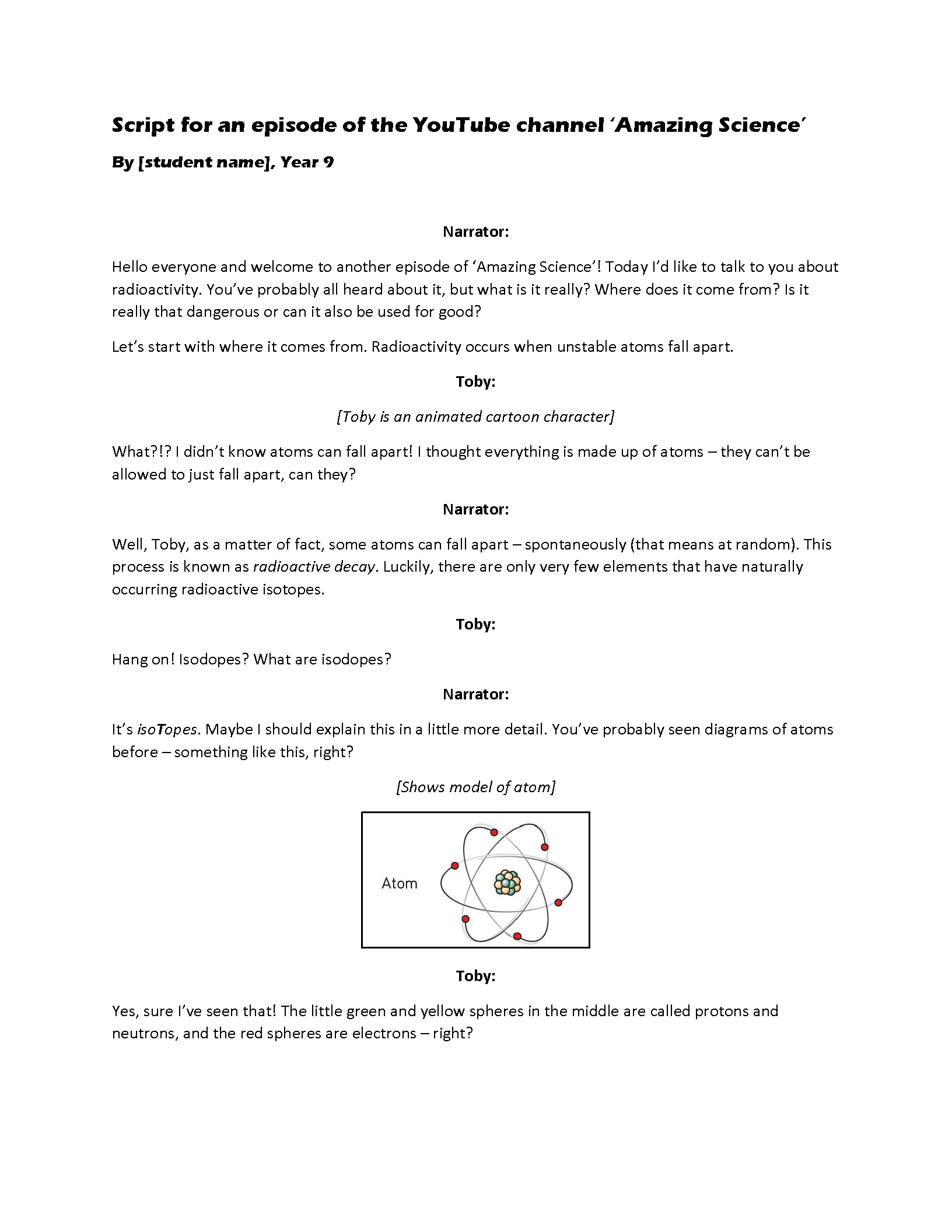 1
Annotation 1
1
Annotation 1
Uses imaginative device to appropriately engage with target audience
-
Annotations
-
1
Annotation 1
Uses imaginative device to appropriately engage with target audience
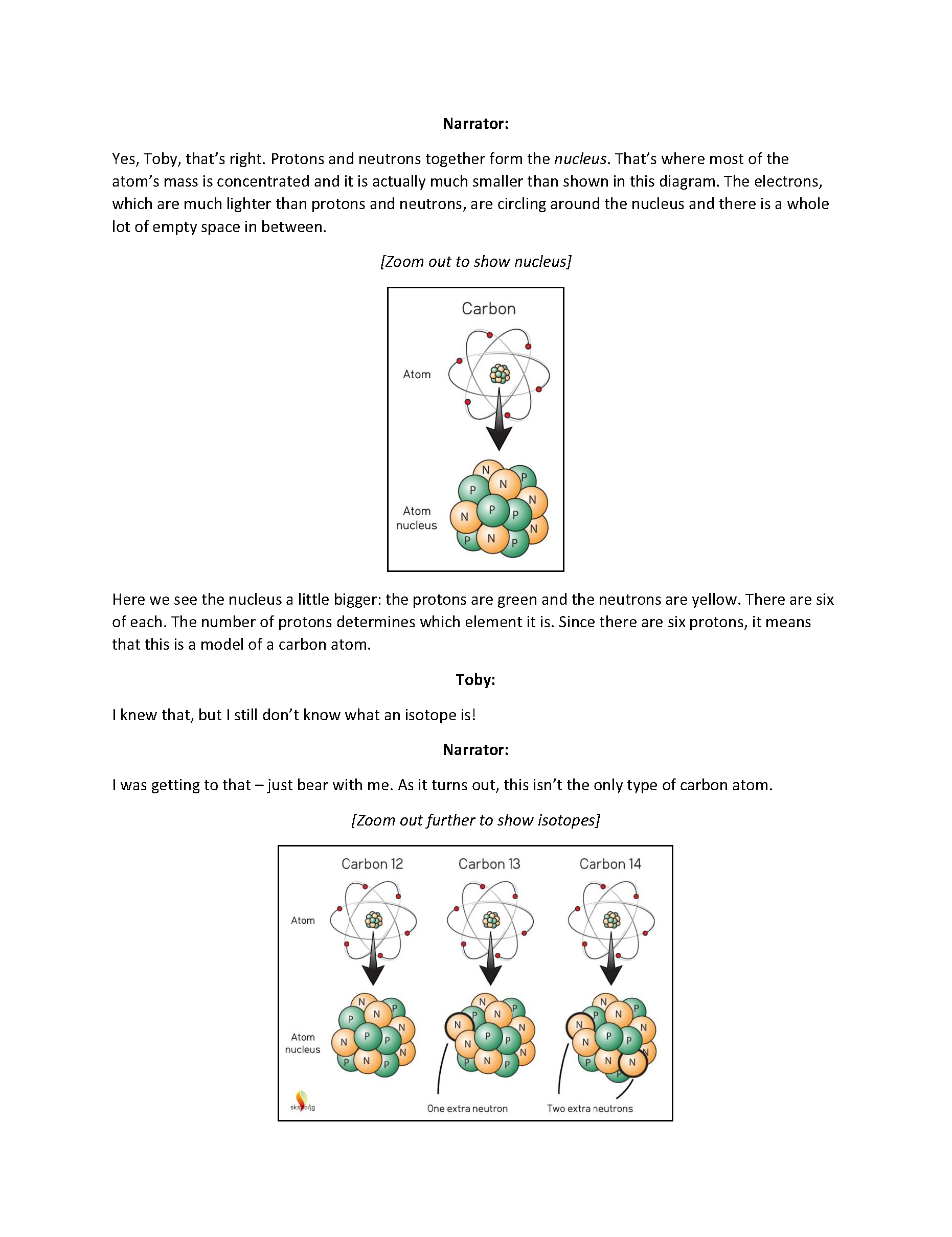 1
Annotation 1
1
Annotation 1
Uses diagram to explain model of atom
-
Annotations
-
1
Annotation 1
Uses diagram to explain model of atom
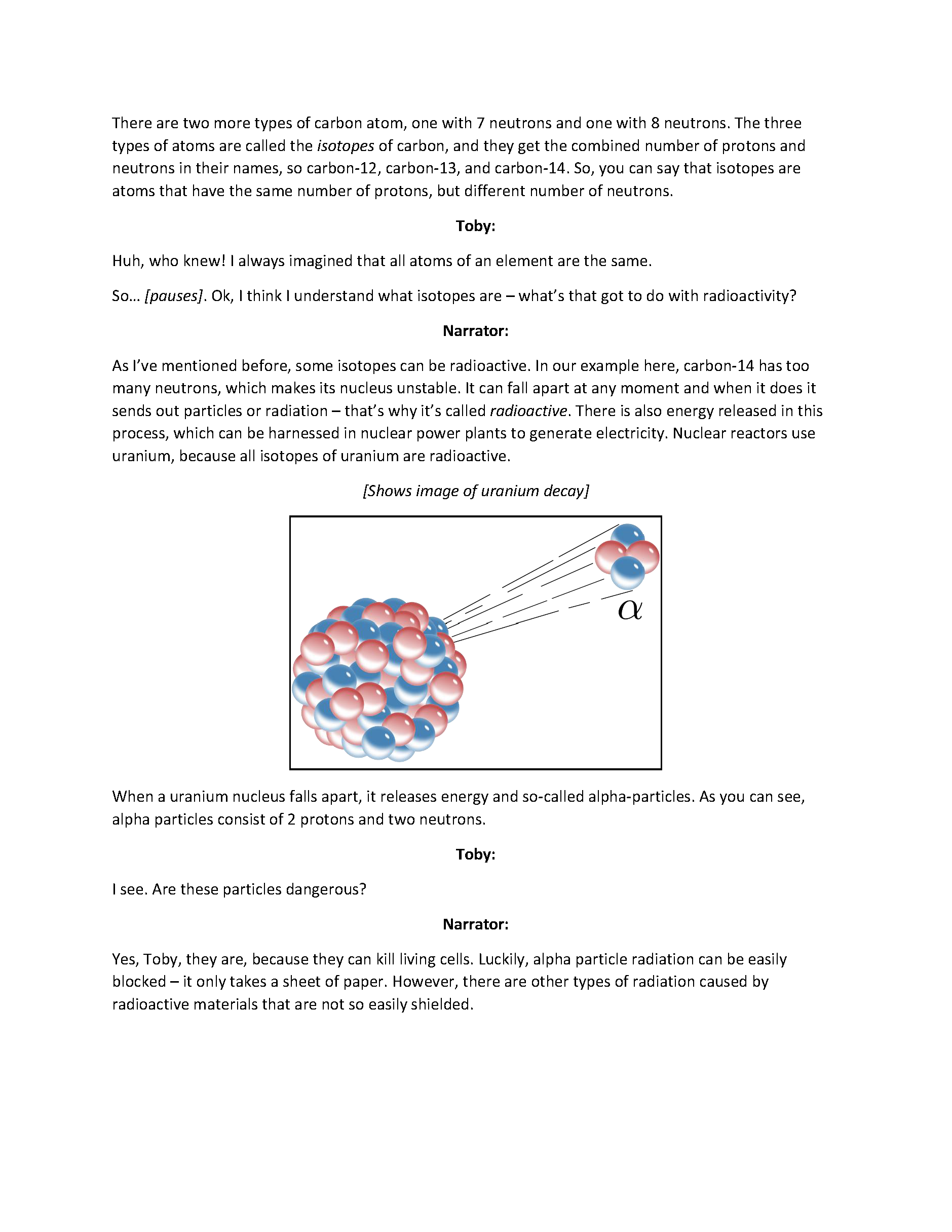 1
Annotation 1
1
Annotation 1
Provides explanation of isotopes 2 Annotation 2
States cause of radioactivity, describes its main effect and identifies one possible application
-
Annotations
-
1
Annotation 1
Provides explanation of isotopes -
2
Annotation 2
States cause of radioactivity, describes its main effect and identifies one possible application
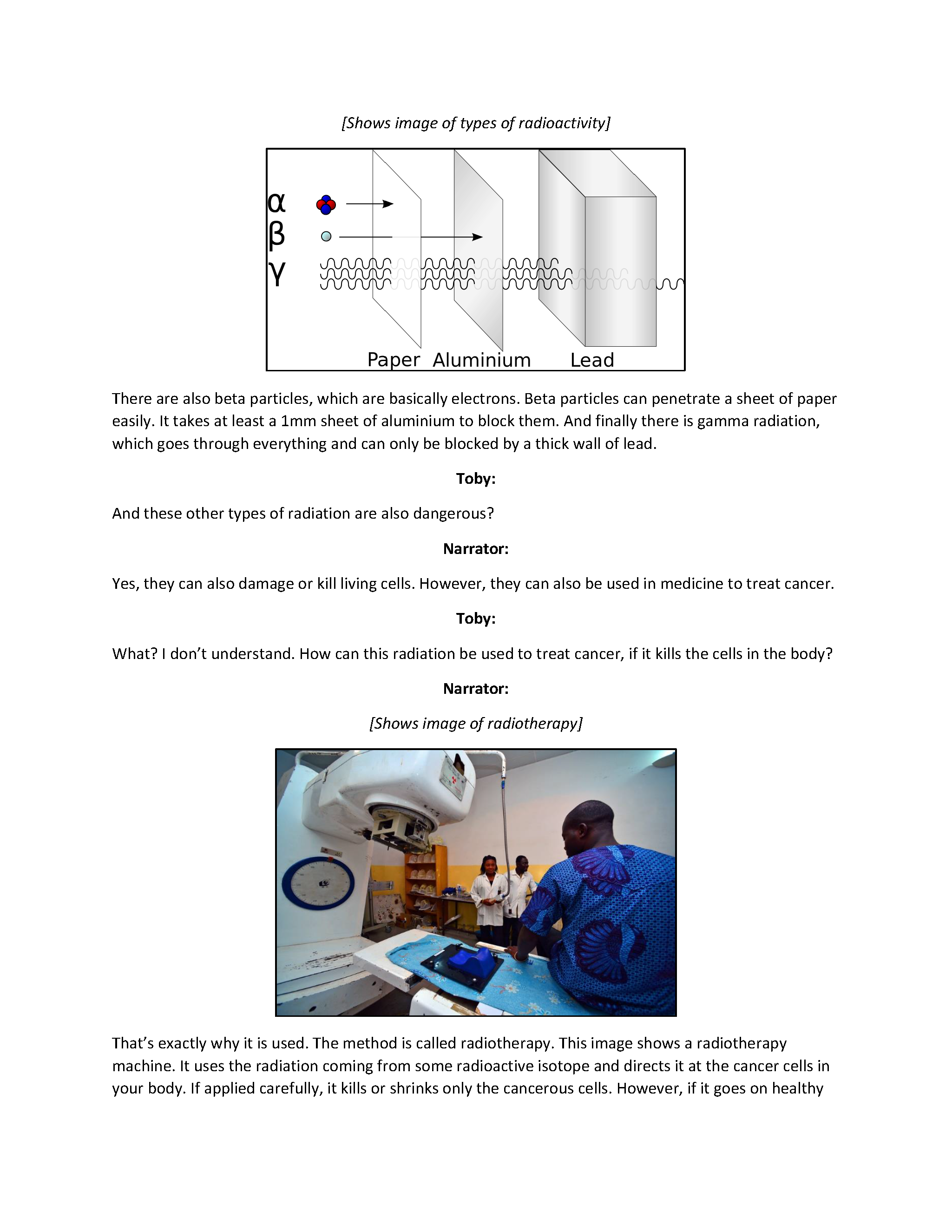 1
Annotation 1
1
Annotation 1
Uses diagram to describe types of radioactivity 2 Annotation 2
Describes one medical application of radioactivity with reference to beneficial and detrimental effects on patients
-
Annotations
-
1
Annotation 1
Uses diagram to describe types of radioactivity -
2
Annotation 2
Describes one medical application of radioactivity with reference to beneficial and detrimental effects on patients
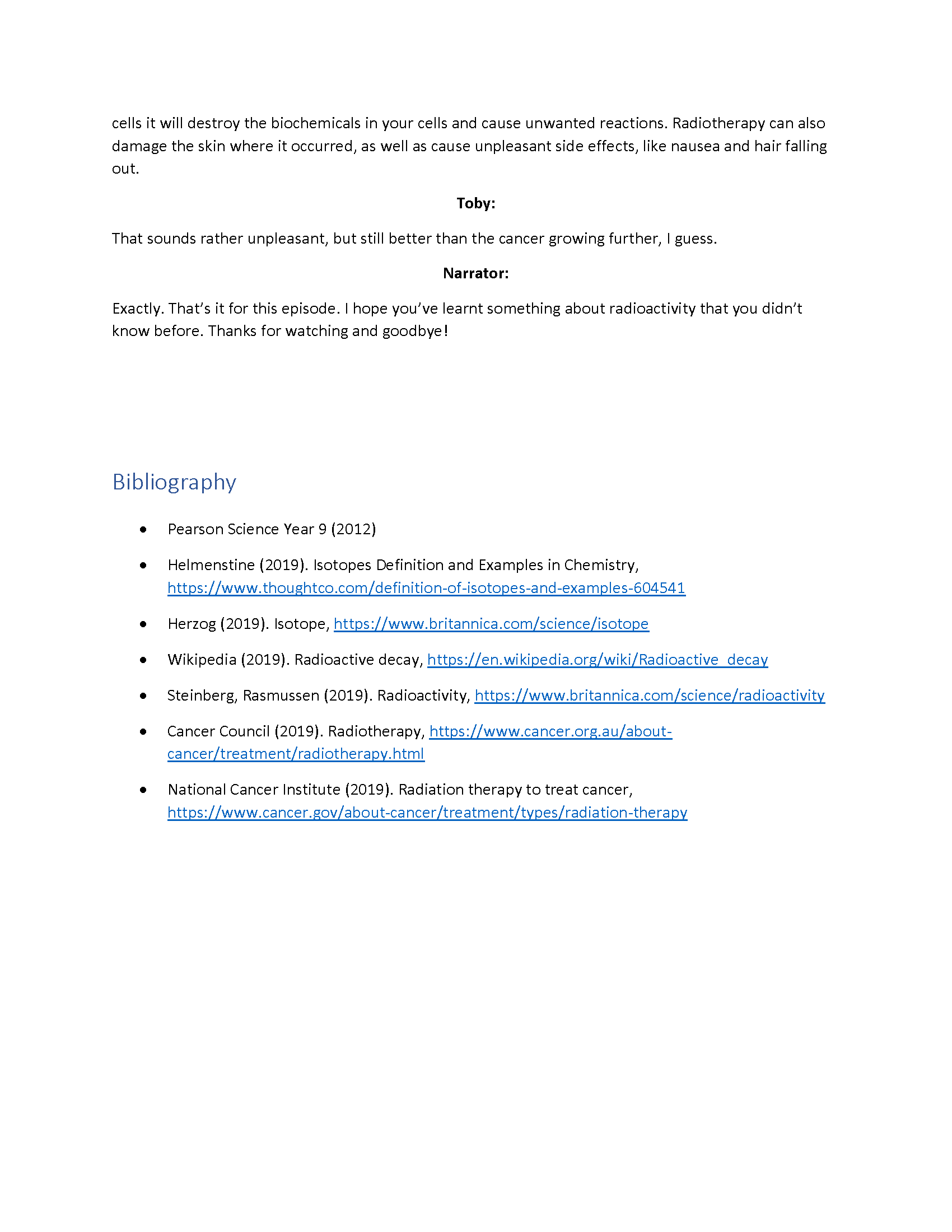 1
Annotation 1
1
Annotation 1
Provides list of sources used to research topic
-
Annotations
-
1
Annotation 1
Provides list of sources used to research topic
Copyright
-
Page 1 – “Carbon 12,13 and 14” by Sceptical Science Graphics is licensed under CC BY 3.0 / cropped and partially erased from original
Page 2, top – “Carbon 12,13 and 14” by Sceptical Science Graphics is licensed under CC BY 3.0 / cropped from original
Page 2, bottom – “Carbon 12,13 and 14” by Sceptical Science Graphics is licensed under CC BY 3.0
Page 3 – image attribution missing
Page 4, top – “Illustration of the relative abilities of three different types of ionizing radiation to penetrate solid matter” by Stannered is licensed by CC BY 2.5
Above satisfactory
Radioactivity and its application
 1
Annotation 1
1
Annotation 1
Acknowledges that scientific understanding develops over time and results from many individual contributions 2 Annotation 2
Describes and contrasts different historical models of the atom
-
Annotations
-
1
Annotation 1
Acknowledges that scientific understanding develops over time and results from many individual contributions -
2
Annotation 2
Describes and contrasts different historical models of the atom
 1
Annotation 1
1
Annotation 1
Draws diagram of an atom including electron shells 2 Annotation 2
Explains how electrons are organised into shells
-
Annotations
-
1
Annotation 1
Draws diagram of an atom including electron shells -
2
Annotation 2
Explains how electrons are organised into shells
 1
Annotation 1
1
Annotation 1
Explains what isotopes are with references to relative abundances and correct scientific notation
-
Annotations
-
1
Annotation 1
Explains what isotopes are with references to relative abundances and correct scientific notation
 1
Annotation 1
1
Annotation 1
States cause of radioactivity 2 Annotation 2
Uses graph to explain the quantitative nature of radioactive decay including term half-life
-
Annotations
-
1
Annotation 1
States cause of radioactivity -
2
Annotation 2
Uses graph to explain the quantitative nature of radioactive decay including term half-life
 1
Annotation 1
1
Annotation 1
Identifies and describes composition and range of different types of radioactive radiation 2 Annotation 2
Explains why radioactive radiation is harmful
-
Annotations
-
1
Annotation 1
Identifies and describes composition and range of different types of radioactive radiation -
2
Annotation 2
Explains why radioactive radiation is harmful
 1
Annotation 1
1
Annotation 1
Uses diagram to explain how radioactivity may cause cancer, referencing DNA and cell mutation 2 Annotation 2
Describes how radiotherapy is used to treat cancer and lists some of its possible adverse effects on patients
-
Annotations
-
1
Annotation 1
Uses diagram to explain how radioactivity may cause cancer, referencing DNA and cell mutation -
2
Annotation 2
Describes how radiotherapy is used to treat cancer and lists some of its possible adverse effects on patients
 1
Annotation 1
1
Annotation 1
Provides list of sources used to research topic
-
Annotations
-
1
Annotation 1
Provides list of sources used to research topic
Copyright
Page 3, top – “Illustration of the atomic structure of carbon isotopes” by Andreas Schmittner is licensed under CC BY-NC 4.0
Page 3, bottom – “The element carbon” by Howard University is licensed under CC BY-NC-SA 3.0
Page 4 – “The decay of Cobalt-60” by H. Abozenadah, A. Bishop, S. Bittner, S. and P. M. Flatt is licensed under CC BY-NC-SA 4.0
Page 5, top – “Three most common modes of nuclear decay” by S. Bewick, R. Parsons, T. Forsythe, S. Robinson, & J. Dupon is licensed under CC BY-NC-SA 3.0
Page 5, bottom – “Illustration of the relative abilities of three different types of ionizing radiation to penetrate solid matter” by Stannered is licensed by CC BY 2.5
Page 6, top – “Radiation can harm biological systems by damaging the DNA of cells” provided by Open Stax College is licensed CC BY: Attribution
Page 6, bottom – “The cartoon in (a) shows a cobalt-60 machine used in the treatment of cancer. The diagram in (b) shows how the gantry of the Co-60 machine swings through and arc” by Rice University is licensed under CC BY 4.0